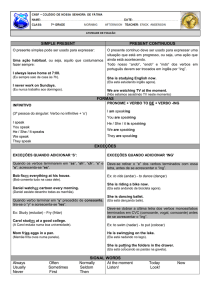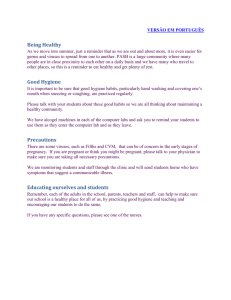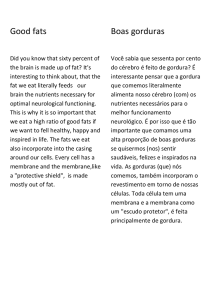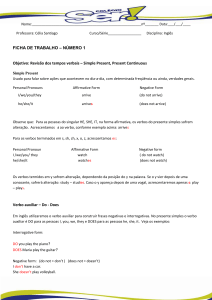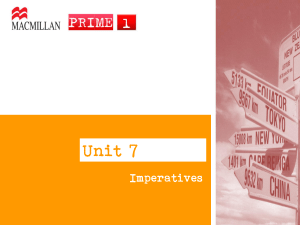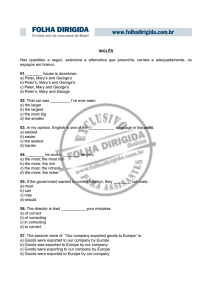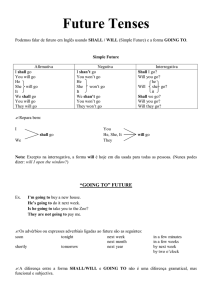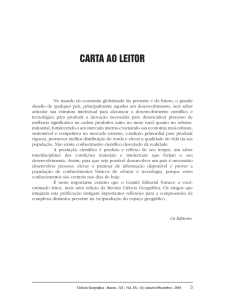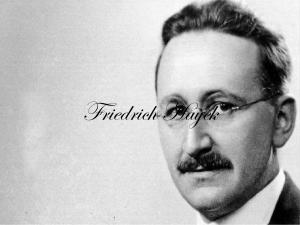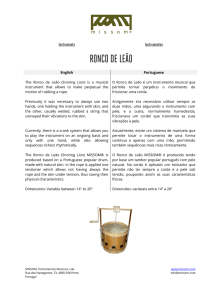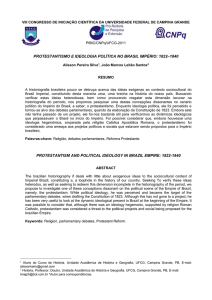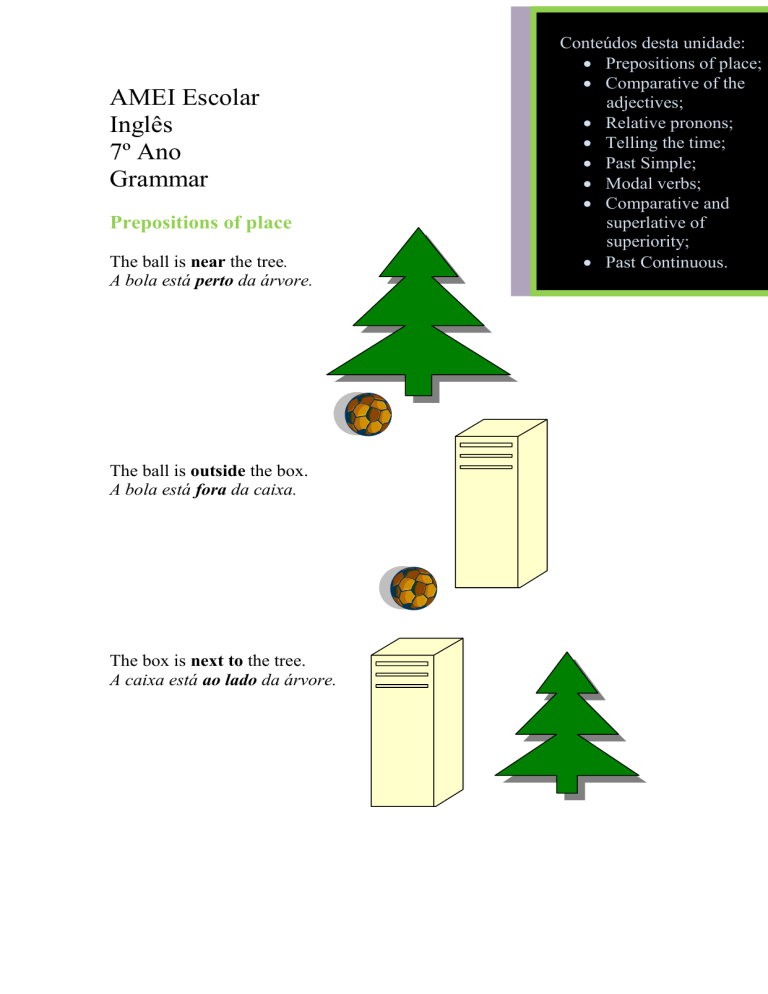
AMEI Escolar
Inglês
7º Ano
Grammar
Prepositions of place
The ball is near the tree.
A bola está perto da árvore.
The ball is outside the box.
A bola está fora da caixa.
The box is next to the tree.
A caixa está ao lado da árvore.
Conteúdos desta unidade:
Prepositions of place;
Comparative of the
adjectives;
Relative pronons;
Telling the time;
Past Simple;
Modal verbs;
Comparative and
superlative of
superiority;
Past Continuous.
The ball is behind the box.
A bola está atrás da caxa.
The paper is in the file.
O papel está no (dentro de) ficheiro.
The paper is inside the file.
O papel está dentro do ficheiro.
The ball is in front of the tree.
A bola está à frente da árvore.
The paper is on the desk.
O papel está na (em cima de) secretária.
The ball is under the desk.
O bola está debaixo da secretária.
The tree is beside the box.
A árvore está lado a lado com a caixa.
Comparative of the adjectives
Comparative of superiority
Para formar o comparativo de superioridade dos
adjectivos com apenas uma sílaba, acrescentase -er ao adjectivo.
Vocabulary:
than - do que
Mary-Kate is younger than Ashley.
No caso dos adjectivos com duas sílabas,
terminados em -y, o -y transforma-se em -i e
acrescenta-se -er> -ier.
Alanis is happier than Wade.
No caso dos adjectivos com apenas uma sílaba, com vogal entre duas
consoantes, dobra a última consoante e acrescenta-se -er.
Mary-Kate is thinner than Ashley.
Todos os adjectivos com duas ou mais sílabas formam o comparativo
de superioridade com a palavra more antes do adjectivo.
Mary-Kate is more beautiful than Ashley.
Há adjectivos que são considerados irregulares: good - better, bad worse e far - further, farther.
Comparative of equality:
Para formar o comparativo de igualdade dos adjectivos, coloca-se o
adjectivo entre as expressões “as … as”.
Mary-Kate is as nice as Ashley.
Aaron is as handsome as his brother.
Comparative of inferiority:
Para formar o comparativo de igualdade dos adjectivos, coloca-se o
adjectivo entre as expressões “isn’t as … as” ou coloca-se a
expressão less antes do adjectivo.
Mary-Kate isn’t as interesting as her sister.
Aaron is less tall than her twin-sister.
Relative pronons
A teacher is someone who explains and teaches
things to students.
A book is something which is used to student.
A hospital is the place where sick people stay.
Who, which e where significam que e são usados, respectivamente
para se refeir a pessoas, a coisas/objectos e animais e a lugares.
Telling the time
To
Past
Quando nos referimos a uma hora certa utilizamos a expressão
o’clock.
06:00 - It’s six o’clock.
Quando nos referimos a uma hora cujo os minutos se situam entre 1
e 29 utilizamos a expressão past, que se traduz por “passa(m)…
das”. Assim, contamos os minutos que passam da hora no decorrer.
07:22 - It’s twenty-two past seven.
(Passam vinte e dois minutos das sete.)
Quando nos referimos a uma hora e meia utilizamos a expressão
half past.
18:30 - It’s a half past six.
Quando nos referimos a uma hora cujo os minutos se situam entre
entre 31 e 59 utilizamos a expressão to, que se traduz por
“falta(m)… para”. Assim, contamos os minutos que faltam para a
hora seguinte.
03:55 - It’s five to four.
(Faltam cinco minutos para as quarto.)
Quando nos referimos a uma hora e um quarto ou a uma hora
menos um quarto utilizamos na mesma a expressão past e to mais a
expressão “a quarter”.
02:45 - It’s a quarter to three.
15:15 - It’s a quarter past three.
Quando nos referimos a uma hora que é entre a meia-noite e o
meio-dia utilizamos a expressão a.m. Quando nos referimos a uma
hora que é entre o meio-dia e a meia-noite utilizamos a expressão
p.m. Quando utilizamos estas duas expressões não utilizamos a
expressão o’clock.
05:00 - It’s five a.m.
17:00 - It’s five p.m.
Past Simple
Utiliza-se o Past Simple para nos referirmos a acções que
aconteceram e treminaram no passado.
Os advérbios e as expressões utilizadas com o Past Simple são:
yesterday - ontem
last night/week/month/year/summer/... - na noite/na
semana/no mês/ no ano/no Verão/... passado(a)
3 days/2 monts/5 years/... ago - à 3 dias/2 meses/5 anos/...
atrás
...
Para formar a afirmativa dos verbos regulares no Past Simple
estuda com atenção as regras do quadro.
Rule:
Regra Geral: acrescenta-se -ed.
Quando termina em -e acrescenta-se
-d.
Quando termina em vogal + y
acrescenta-se -ed.
Quando termina em consoante + y,
o y passa a i e acrecenta-se -ed.
Example:
Last week, Susana painted a poster.
Yesterday, I used your pencil.
Last month, Jude stayed at hospital.
Last night, I studied English.
Para formar a afirmativa dos verbos irregulares no Past Simple
temos de conhecer a lista dos verbos (anexo). Os mais importantes a
decorar são os verbos TO BE e TO DO.
I
You
She, He, It
We
You
They
I
You
She, He, It
We
You
They
TO BE
Affirmative
Negative
was
wasn’t / was not
were
weren’t / were not
was
wasn’t / was not
were
weren’t / were not
were
weren’t / were not
were
weren’t / were not
TO DO
Affirmative
Negative
did
didn’t / did not
did
didn’t / did not
did
didn’t / did not
did
didn’t / did not
did
didn’t / did not
did
didn’t / did not
Interrogative
Was I?
Were you?
Was she, he, it?
Were we?
Were you?
Were they?
Interrogative
Did I?
Did you
Did she, he, it?
Did we
Did you?
Did they?
Para formar a negativa dos verbos regulares e irregulares no Past
Simple utiliza-se o verbo auxiliar didn’t mais o verbo principal no
infinitivo.
The teacher didn’t close the door.
John didn’t go to Japan.
Para formar a interrogativa dos verbos regulares e irregulares no
Past Simple colocamos o verbo auxiliar did mais o nome ou
pronome mais o verbo principal no infinitivo.
Did the teacher close the door?
Did John go to Japan?
Modal verbs
I
You
She, He, It
We
You
They
I
You
She, He, It
We
You
They
TO CAN (poder)
Affirmative
Negative
can
can’t / can not
can
can’t / can not
can
can’t / can not
can
can’t / can not
can
can’t / can not
can
can’t / can not
TO MUST (dever)
Affirmative
Negative
must
mustn’t / must not
must
mustn’t / must not
must
mustn’t / must not
must
mustn’t / must not
must
mustn’t / must not
must
mustn’t / must not
Interrogative
Can I?
Can you?
Can she, he, it?
Can we?
Can you?
Can they?
Interrogative
Must I?
Must you
Must she, he, it?
Must we
Must you?
Must they?
Jane can speak French fluently.
Students must do their homework every day.
Students mustn’t use mobile phones in the classroom.
Comparative and Superlative of Superiority
Relembra o comparativo de superioridade e aprende o superlativo de
superioridade. Compara e sistematiza com ajuda da tabela.
Comparative of
Superiority:
Adjectivos com
apenas uma sílaba adjectivo + -er + than
Ex: Gwen is taller than
Wendy.
Adjectivos com
duas sílabas
terminados em -y
Superlative of
Superiority:
the + adjectivo + -est
Ex: Martha is the tallest
girl on the camp site.
adjectivo + -y + -ier + than the + adjectivo + -y + -iest
Ex: Martha is happier
than Wendy.
Ex: John is the happiest
boy on the group.
Adjectivos de
uma sílaba
terminados em
vogal entre duas
consoantes
Adjectivos com
duas ou mais
sílabas
(adjectivos
longos)
adjectivo + última
consoante + -er + than
the + adjective + última
consoante + -est
Ex: John’s dog is bigger
than Martha’s cat.
Ex: Wendy’s house is the
biggest in the
neighbourhood.
more + adjectivo + than
the + most + adjectivo
Ex: Wendy is more
beautiful than Gwen.
Ex: Martha is the most
beautiful girl in your class.
Irregulars Adjectives
Adjective
good
bad
far
Comparative
better than
worse than
further/farther than
Superlative
the best
the worse
the further
Past Continuous
Para formar o Past Continuous, utilizamos o verbo auxiliar TO BE e
acrescentamos -ing ao verbo.
I was reading an adventure book, last night.
You were studying Maths, last afternoon.
Usa-se o Past Continuous para:
acções que tiveram uma longa duração no passado.
I was playing computer games all day.
acções que ocorreram num tempo especifico e exacto na
passado.
Gwen was having lunch at one o’clock.
duas actividades que estavam a ocorrer ao mesmo tempo no
passado.
While Wendy was writing a letter her friend
was waiting for him.

